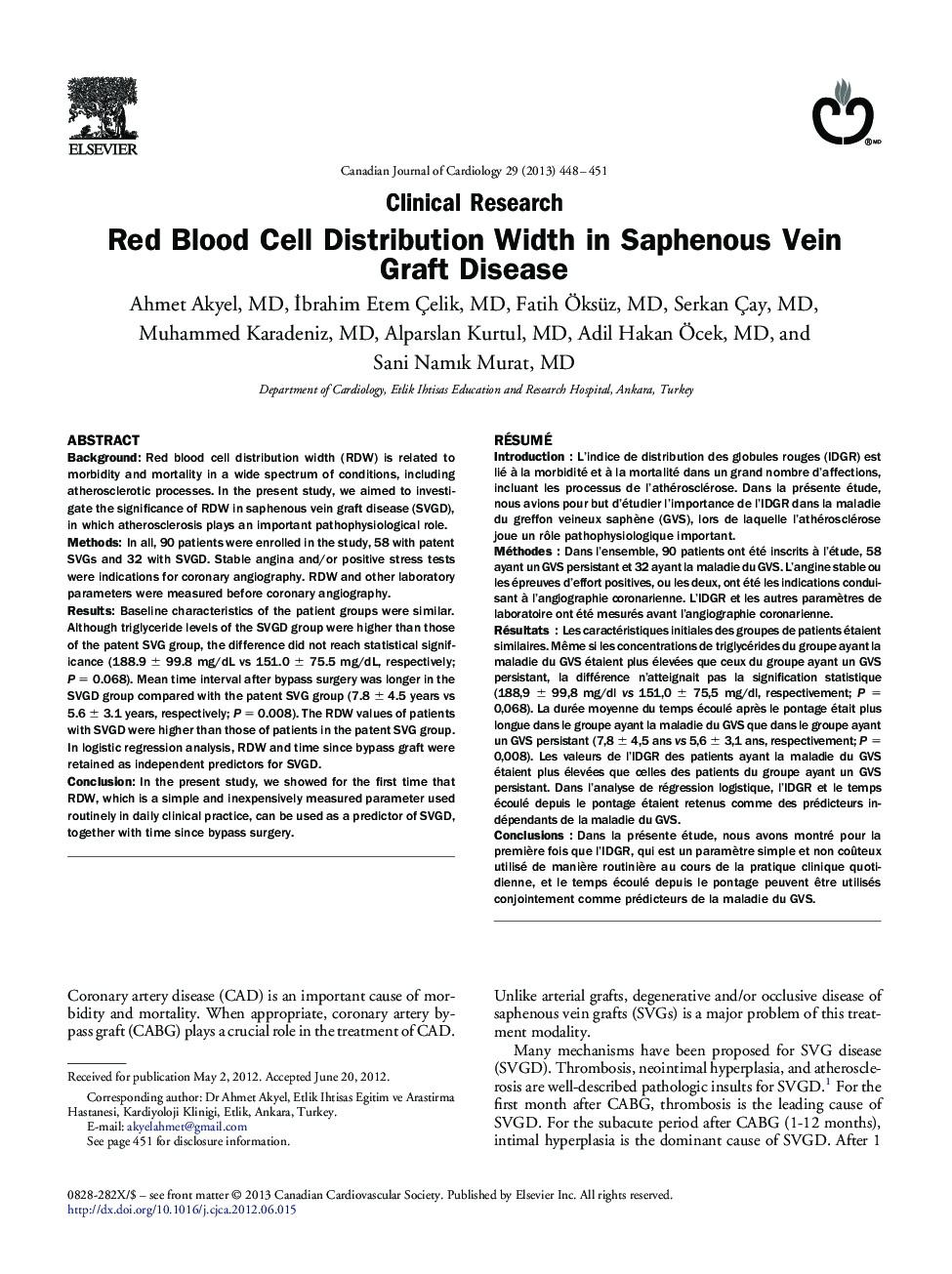| کد مقاله | کد نشریه | سال انتشار | مقاله انگلیسی | نسخه تمام متن |
|---|---|---|---|---|
| 2727730 | 1566528 | 2013 | 4 صفحه PDF | دانلود رایگان |

BackgroundRed blood cell distribution width (RDW) is related to morbidity and mortality in a wide spectrum of conditions, including atherosclerotic processes. In the present study, we aimed to investigate the significance of RDW in saphenous vein graft disease (SVGD), in which atherosclerosis plays an important pathophysiological role.MethodsIn all, 90 patients were enrolled in the study, 58 with patent SVGs and 32 with SVGD. Stable angina and/or positive stress tests were indications for coronary angiography. RDW and other laboratory parameters were measured before coronary angiography.ResultsBaseline characteristics of the patient groups were similar. Although triglyceride levels of the SVGD group were higher than those of the patent SVG group, the difference did not reach statistical significance (188.9 ± 99.8 mg/dL vs 151.0 ± 75.5 mg/dL, respectively; P = 0.068). Mean time interval after bypass surgery was longer in the SVGD group compared with the patent SVG group (7.8 ± 4.5 years vs 5.6 ± 3.1 years, respectively; P = 0.008). The RDW values of patients with SVGD were higher than those of patients in the patent SVG group. In logistic regression analysis, RDW and time since bypass graft were retained as independent predictors for SVGD.ConclusionIn the present study, we showed for the first time that RDW, which is a simple and inexpensively measured parameter used routinely in daily clinical practice, can be used as a predictor of SVGD, together with time since bypass surgery.
RésuméIntroductionL'indice de distribution des globules rouges (IDGR) est lié à la morbidité et à la mortalité dans un grand nombre d'affections, incluant les processus de l'athérosclérose. Dans la présente étude, nous avions pour but d'étudier l'importance de l'IDGR dans la maladie du greffon veineux saphène (GVS), lors de laquelle l'athérosclérose joue un rôle pathophysiologique important.MéthodesDans l'ensemble, 90 patients ont été inscrits à l'étude, 58 ayant un GVS persistant et 32 ayant la maladie du GVS. L'angine stable ou les épreuves d'effort positives, ou les deux, ont été les indications conduisant à l'angiographie coronarienne. L'IDGR et les autres paramètres de laboratoire ont été mesurés avant l'angiographie coronarienne.RésultatsLes caractéristiques initiales des groupes de patients étaient similaires. Même si les concentrations de triglycérides du groupe ayant la maladie du GVS étaient plus élevées que ceux du groupe ayant un GVS persistant, la différence n'atteignait pas la signification statistique (188,9 ± 99,8 mg/dl vs 151,0 ± 75,5 mg/dl, respectivement; P = 0,068). La durée moyenne du temps écoulé après le pontage était plus longue dans le groupe ayant la maladie du GVS que dans le groupe ayant un GVS persistant (7,8 ± 4,5 ans vs 5,6 ± 3,1 ans, respectivement; P = 0,008). Les valeurs de l'IDGR des patients ayant la maladie du GVS étaient plus élevées que celles des patients du groupe ayant un GVS persistant. Dans l'analyse de régression logistique, l'IDGR et le temps écoulé depuis le pontage étaient retenus comme des prédicteurs indépendants de la maladie du GVS.ConclusionsDans la présente étude, nous avons montré pour la première fois que l'IDGR, qui est un paramètre simple et non coûteux utilisé de manière routinière au cours de la pratique clinique quotidienne, et le temps écoulé depuis le pontage peuvent être utilisés conjointement comme prédicteurs de la maladie du GVS.
Journal: Canadian Journal of Cardiology - Volume 29, Issue 4, April 2013, Pages 448–451